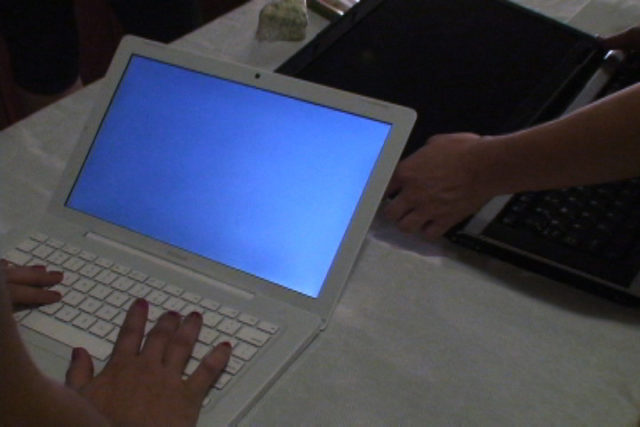A weekly on-line screening series selected by Vtape staff @ www.vtape.org
on-line Friday May 29, 2020
JENNIFER CHAN, Screen Saver (3:46, 2010) is the ninth in this series, selected by Deirdre Logue, Development Director
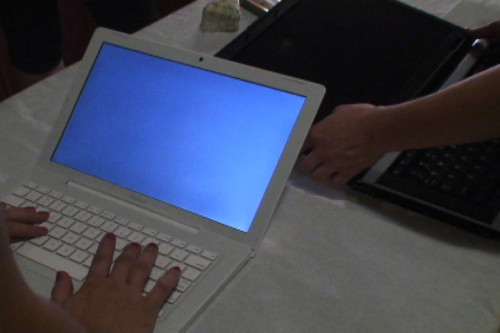
“Experiments in anti-social networking.” – Images Festival, 2012
Deidre Logue says about her selection:
“I have been having a lot of trouble with my Internet and I thought maybe it was my router. So I called Apple for help to set up my iMac because I still hadn’t finished uploading and installing High Sierra. They asked me to verify the phone number and password I had attached to my Outlook. So I turned off my virus protection and changed users. But now my phone for some reason doesn’t want to turn on and keeps blinking the Apple logo. I contacted customer support at my closest iStore and restarted my computer because they asked me to. Then I got my debit card stolen from Apple games and can’t download any of my apps. I upgraded to 13.4.1 OS but that affected Safari.
“A nice person at Chrome support gave me a new password, which I used to reset Time Machine and to update my files to the iCloud in Excel. Word reconnected me to my iMac via iTunes where I got the air pods. But my left ear pod stopped working and the case has metal fragments in it. When I called Amazon to return them I was told they won’t take them back after two weeks.
“The kid I spoke to was arrogant. Of course once I got on the phone, they said there’s nothing they could do to help me. When I go back to their website and try to contact support I get the 403 forbidden page.”
========================================
While some festivals and other screening venues are cancelling or postponing their events, others, like the 2020 Internationale Kurzfilmtage Oberhausen, have moved on-line with their screenings, and we all enjoyed as many of the Oberhausen programmes as we could take in – over 350 films available! – and the wonderful q&a’s with the artists afterwards.
Meanwhile, educators and librarians are adjusting to this “new normal,” getting titles up on-line for instructors to use in their virtual classrooms over the summer and probably right into the fall. Vtape is providing files from our remote server and previews are available for viewing through our portal so programmers and curators and researchers have access to the work of Vtape artists. For access contact wandav@vtape.org.
Still working from home, we found a way to keep the amazing artists’ titles we distribute in circulation. With REFLECTION / REFRACTION we are doing a virtual version of this love letter to our artists. Every Friday for 9 weeks we have launched a title selected by one of the Vtape staff, accompanied by a personal statement as to why this work speaks to each person. Atomized as we are – isolated from each other, separated from the works of art that we love – we launched the artworks on our website so that you have seen a new title each week. Now it’s time to begin something new. Starting the next Friday morning, June 5, we will begin seeing the program selected by Yaniya Lee, fractured horizon – a view from the body, a series of 8 titles, one available each week, launched on Friday mornings. – Lisa Steele, Artistic Director
TOM KALIN, They Are Lost To Vision Altogether (13:00, 1989) is the eighth in this series, selected by Kim Tomczak, Restoration & Collections Management Director
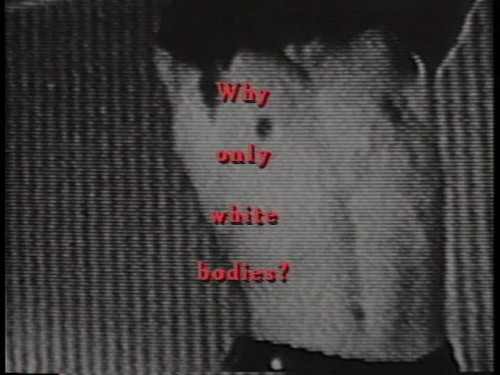
“They Are Lost To Vision Altogether attempts to reclaim eroticism and to address the contradictions of sexuality and romance in the face of a monolithic and culturally compulsory heterosexuality … it freely admits ambivalence and attempts to ‘not be lost or pushed into the sea of what others believe to be our collective history.’”
Kim Tomczak says about his selection:
“Watching Tom Kalin’s video makes me sad, but I have watched it dozens of times. It makes me sad because I see so many friends, colleagues and folks I admired, each one of them passed away in the AIDS / HIV pandemic. What could be sadder than remembering the passing of so many amazing people? Not remembering would be so much worse, so thanks again Tom for giving me my memories.”
EVA TEPPE, The world is everything that is the case (2:07, 2003) is the seventh in this series, selected by Alice Evensen, Digitization Associate
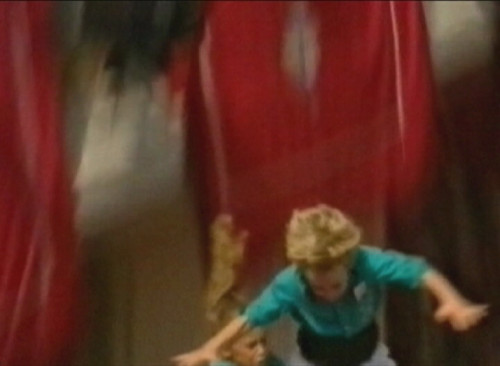
“In the course of large fiestas these Spanish athletic groups compete with one another to form the highest tower (‘castell’) composed of people with the ever-imminent risk that the human pyramid could end up collapsing like a house of cards, bringing all the participants tumbling down.” (Ludwig Seyfarth)
Alice Evensen says about her selection:
“In slow-motion clips bodies drift and twist in free-fall down the screen, while I race to grasp at the images flashing though my mind, scattering like beads of a snapped necklace.
“Bosch, Goya, Icarus, the descent, the fall, infamous news images, the bone-crunching tumbles of athletes in the Netflix docu-series Cheer, my own childhood tumbles…
“But in Teppe’s video we don’t really see these falls to completion. The monotonous screech of the horror movie-like soundtrack underscores the isolated moment of suspension.
“A line from the film La Haine…a man falling from a 50 story building says to himself ‘Jusqu’ici tout va bien… Jusqu’ici tout va bien… Jusqu’ici tout va bien…’ A horror of denial.
“What is risk? What is risked? Who risks? What is failure and who is failed? In a pyramid/a castle/a tower? An obsession with hierarchy? A possession by hierarchy?”
BUSEJE BAILEY, BLOOD (6:00, 1992), is the sixth in this series, selected by Kiera Boult, Submissions, Collections & Outreach Coordinator
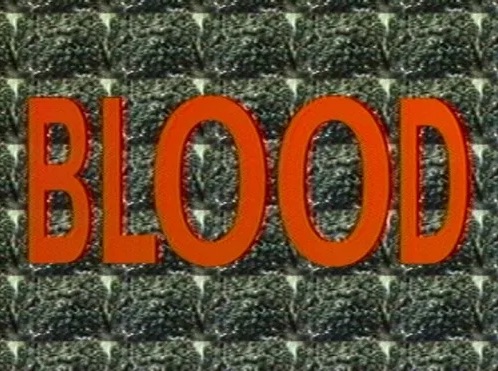
“This tape deals with a personal, intense view of self – race and representation. A sense of personally touching the sexual self, of representing one’s sexuality. It is a reaction to the exploitation of Black Women’s sexuality in history and contemporary media imaging. This is a metaphor for rage.”
Kiera Boult says about her selection:
“In Buseje Bailey’s Blood (1992) we anticipate the sound of falling water, but instead the distorted sounds of introspection echo. This work shares our most protected self, the one we are in isolation, the part that requires no articulation but silence.
“As life moves online the distinction between public and private fades, solitude no longer is for the self but for the public.”
ERIKA DEFREITAS, Her body is full of light (often, very often, and in floods) (4:22, 2016) is the fifth in this series, selected by Wanda vanderStoop, Distribution Director
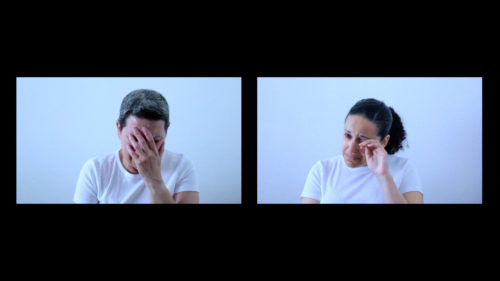
“An image that has lived with the artist for some time now, has been of her and her mother laughing hysterically to the point of tears. When this fleeting image appears, they aren’t sharing the same space. There is a softness to the image – as if the light is shining through them. This imagery invokes the tradition of lamentation in religious texts, the phenomena of the weeping Virgin Mary statues, and the history of hysteria and anxiety.”
Wanda vanderStoop says about her selection:
“I am a listener and this is a deep listening, without words and apart. It is a deep seeing into the other. It’s where I want to settle. To anchor myself.”
JANE WRIGHT, Electronic Sunsets 25, (4:00, 1974), is the fourth in this series, selected by Deidre Simmons, Digital Asset Assistant
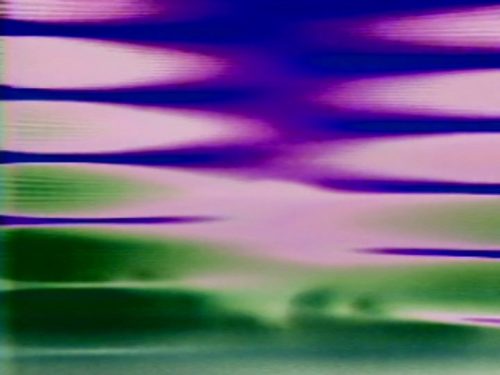
“A series of over 40, 8 minute video landscapes (which can be shown in different combinations, and as an installation) that represent a spiritual experience, meditational, and soothing (note: sunsets 41 and 43 are also known as Music 1 and Music 3).”
Deidre Simmons says about her selection:
“I have been working through Vtape’s collection to ensure that both physical videotapes and digital files are in good shape for preservation, allowing me to watch Jane Wright’s Electronic Sunsets 25 for the very first time. Watching this video landscape while isolating in my bedroom in these weird and uncertain times, I found myself mesmerized by the visual artistry and the accompanying sound. It made me emotional, leaving me sitting with feelings I had been trying to ignore: fear, worry and irritation to name a few. The video has a run-time just under four minutes, so the emotional reaction I had to this work startled me but prompted me to confront feelings that I had been ignoring, and that even though I am extremely grateful to be safe, healthy and financially stable right now, I am still allowed to feel fear, worry and irritation. I have watched this work a few more times since my first time and while I do not have such a strong emotional reaction, I still find myself mesmerized and soothed in a similar way to how a good song can make a person feel devastated during one listen and content on the next.”
JOHAN GRIMONPREZ, Two Travelers to a River, (1:27, 2018), is the third in this series selected by Lisa Steele, Artistic Director
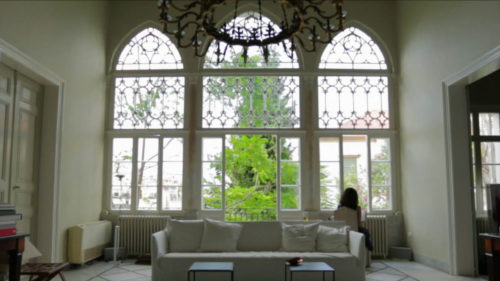
“When asked a question on politics, late Palestinian poet Mahmoud Darwish once answered: ‘I write about love to expose the conditions that don’t allow me to write about love’ In Two Travellers to a River Palestinian actress Manal Khader recites such a poem by Mahmoud Darwish: a concise reflection on how things could have been.”
Lisa Steele says about her selection:
“For Mahmoud Darwish, the river is the place of connection, where love is exchanged and affirmed or perhaps, also, forgotten. He writes, ‘So we have to be worthy, this evening, of ourselves, and of a river that runs along beside us, and that we flow into as it flows into us.’ The fragility of freedom echoes the frail bonds of connection that we seek and sometimes hold and other times lose like water seeping from our outstretched palms.”
ADELE HORNE, Quiero Ver (6:30, 2008), is the second in this series, selected by Chris Gehman, Finance Manager.
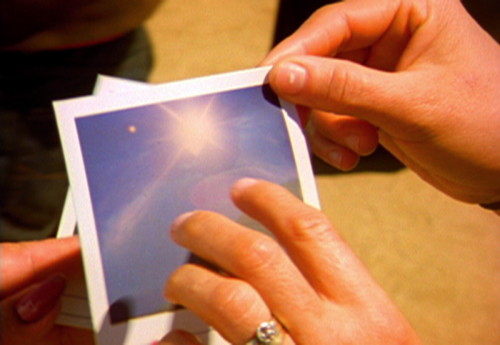
“On the 13th of each month, hundreds of people gather at a site in the Mojave Desert to see visions of the Virgin Mary appear in the sun. They point Polaroid, cell phone, and video cameras at the sun, and compare interpretations of the resulting images.”
Chris Gehman says about his selection:
“Concisely, elegantly, with a sense of immediate identification, Adele Horne draws for us a collective self-portrait. We are those creatures who collectively seek to find meaning – an activity indistinguishable from the invention of meaning. Quiero Ver translates to English as ‘I want to see.’”
TAMAMI ASADA, Screaming Videotape #2, (1996) is the first in our on-line screening series, selected by Dustin Lawrence, Technical and Distribution Coordinator.
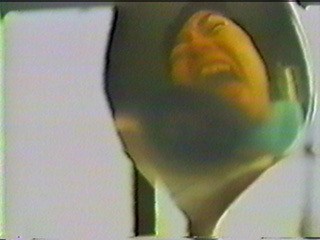
“Self recognition changes according to the condition of mental health. When the person is not healthy, the image of oneself looks distorted like the ones reflected on a spoon.
Maybe screaming happens when the gap between the ideal self and the reflected self is too big. The person is retrieved when he/she forgets about the ideal.”
Dustin Lawrence says about this first selection:
“I often find myself staring out the window, trying to watch the world outside but instead catch myself staring at my own reflection. My reflection always seems to stare disapprovingly, cold eyes and a straight mouth. I feel like I don’t know this person staring back.
“Having haunted me ever since my first viewing, Tamami Asada’s Screaming Videotape #2 made me realize how many others must feel this same way. Looking into mirrors, windows, spoons and wondering who is this staring back? Are they the one screaming? Or is it me?
“Though I don’t struggle personally, or rather openly, with my own mental health, I can feel the separation, the divide between us. Myself and my reflection. I’m trying to understand what it is that connects us. I’m trying to see who I am – really am.”

